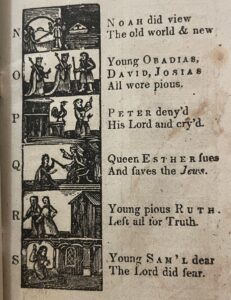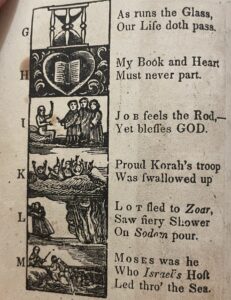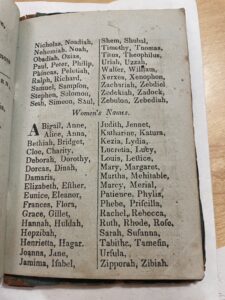
In my previous two blog posts I discussed both how the written text of An Almanack feels, looks, and functions, as well as exploring its previously known owners Hatty and Alice Bird French. An Almanack is not a real almanac at all but is rather The New England Primer; a children’s literacy pamphlet. The pamphlet too must have been a successful form of teaching language to children as its reader, Alice B. French, would become a doctor with her degree from Boston University in 1877. Even with its misleading title, An Almanack intended to teach children how to read and used religion to do so.
The book contains a section meant to teach the alphabet and uses biblical references and images to help children connect to the letters. For example, in figure 1, to teach the letter A the book includes an image of Adam and Eve and reads,

Figure 1 Illustrations and text that accompany the first letters of the alphabet
In ADAM’S Fall We finned all.
And for the letter B,
Heaven to find, The Bible Mind.
This continues for every letter of the alphabet.
The imagery in this alphabet section is very skillful as well, especially for working in a tiny, confined space of an inch and half an inch. This imagery could have been helpful for children learning how to read because images are more appealing and easier to understand than words are, at least when learning a language. I will include images of each of the letters with their drawings and biblical references as they are highly skilled and intriguing to study. (fig. 2) What makes these images particularly interesting is the ability to communicate a story in such a small space and with minimal detail. I also find the difference in font and spacing to emphasize the key portions of the text to be a valuable tool to learning the alphabet in this way. The phrases are also noticeably in a rhyme scheme which could have been to help with the memorization of them, both teaching the alphabet and key biblical stories.

Figure 2 Illustrations and text that accompany the letters of the alphabet 

The book also includes common names of men and women, so that children can learn to spell their names, and actually does specify this use case where the names are located in the text (fig. 3). One of these names is Alice; her sister Hatty does not appear especially due to the odd spelling. This is a fascinating find, as the first pages of An Almanack include the repeated spelling of the girls’ names- perhaps as they practiced their spelling. This to say that the book, at least in the case of the French sisters, reached its intended audience, and may have even been the cause of their learning how to read and write. And with Alice becoming a medical missionary later in her life, teaching through church stories may have been successful in encouraging youth to be church–minded.

Figure 3
List of common names of women, with the intention of teaching children to spell their names
In doing research for this section, I was finally able to find the gift plate that accompanies books given to the Dickinson archives documenting who donated the book. In the case of An Almanack, the Thompson family and Thompson’s Bookstore donated the book to the archives (fig. 4). Thompson’s Bookstore was a shop in Carlisle listed in the Carlisle directory from 1980. The store was located at 56 West High St. and was one of four bookstores in town (fig. 5 & 6). Thompson’s Bookstore however is not in the Carlisle directory from 1985, so the shop closed at some point in the years between 1980 and1985. The building that formerly housed Thompson’s Bookstore in town is now Georgie Lou’s Retro Candy.

Figure 6
The former location of Thompson’s Bookstore on a modern map

Figure 5
Thompson’s Bookstore information in the Carlisle Directory of 1980

Figure 4
The gift plate for An Almanack
What is interesting about the gift plate itself is the design; the archives only used it between 1973 and 1987. In 1987, Dickinson had an international competition asking for a gift plate redesign. So, no books that entered the archives after the year 1987 would have the retired design that is on An Almanacks gift plate. An Almanack was likely to enter the Dickinson archival collection between 1973 and 1985 based on the timeline of the bookstore and the gift plate. The Dickinson archivist James Gerencser too shared that when Thompson’s Bookstore closed, they had an auction of the books that remained. Whether the archives bought this book at auction for the archives, or the Thompson family truly gifted it is unknown. Regardless the book entered the collection after previously being a part of Thompson’s Bookstore in Carlisle.
An Almanack is a unique little book. Its title does not encompass the text that is within it, and within its pages the book can be contradictory. There are multiple publication dates, multiple title pages, multiple authors, and multiple publishers; which makes the book an interesting collaboration between authors across time. The handwriting left behind helped in gain insight into how the previous owners read this book, and their accomplishments in life showed just how effective this text may have been. The Dickinson archives are incredibly lucky to have An Almanack in its collection.
Works Referenced
AncestryLibrary. Ancestry.com, ancestrylibrary.com. Accessed 2 Nov. 2024.
Dickinson College Archives and Special Collections. Dickinson College, archives.dickinson.edu/.
Newman, H. (1843). An almanack containing an account of the Coelestial Motions, Aspects, &c. For the year of the Christian Empire, 1691. Ira Webster.
Leave a Reply